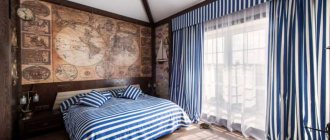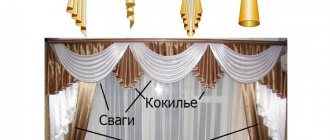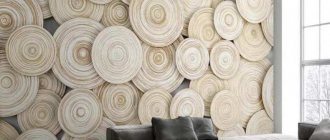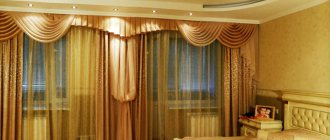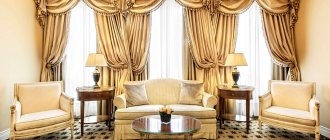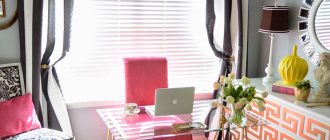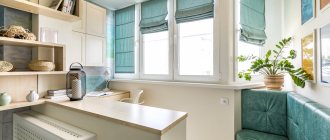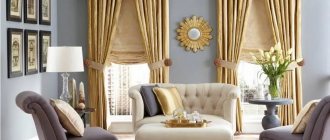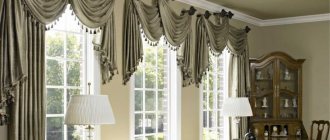The word "lambrequin" is French. It refers to a type of decorative trim or drapery (or simply curtains) that is usually applied at the top of a window or door. It is a simple way to decorate a room.
If you wish, you can easily make openwork curtains yourself. You can also use puffs. And they will look as if they were made by a master. At the same time, sewing these will not take you much time.
So, we sew “lambrequin” curtains. What are they? Lambrequins can be made of fabric contrasting to the main one. So, for example, if thin tulles and curtains are used as the main fabric, then the lambrequins can be satin, silk, with decoration, such as puffs , and no. They occupy about 1/5 of the window. Such curtains can be openwork or have a figured silhouette.
Hard and soft – this is also about the lambrequin. In the first case, we are talking about non-woven curtains that can hold their shape. In the second case, we are talking about those made from special curtain fabric. A rigid lambrequin is difficult to attach - on a separate strip and with the help of eyelets.
At the same time, the hard one can be called more noble and interesting. Where to start? Naturally, many people want to know: how to sew a lambrequin with their own hands. A master class on how to sew a lambrequin - hard or soft, for the kitchen or for the living room - begins with the advice to cover yourself with patterns. In them you can find all the useful information that will allow you to make one curtain or several at once in a simpler way. Lambrequin for the kitchen The master class “Sewing decorative curtains for the kitchen” should begin by listing the list of necessary items.
It includes: main and lining (if you need hard) fabric, non-woven lining, plank, cord for decorative tape. Making a hard lambrequin with your own hands is not at all as difficult as it seems from the outside. Even the classic method of production - on a plywood box - will be within the power of the most fragile craftswoman, and modern materials will help you complete this job in the time required for regular sewing of large-sized items. The edge of the lambrequin can have smooth outlines or sharp corners, edging made of another fabric, or additional decorative elements. None of the methods will be so difficult that it cannot be used for sewing a lambrequin at home.
Selection of materials and tools
The most necessary thing in creating decorative hard-type cornices is a frame.
This is the element that gives the structure immobility and strength. In the classic version (in theaters, Kremlin offices or palace interiors) ordinary plywood is used. But at home, it is best to make do with lightweight modern materials.
Bando or shabrak is a dense non-woven textile material with an adhesive layer applied to it. Different manufacturers have different options for bandeaus: thick and thin, self-adhesive or requiring additional processing, double-sided and single-sided.
Therefore, choosing the right quality of material does not seem particularly difficult. You can buy shabrak or dublerin in fabric stores and handicraft departments. There you need to stock up on related materials and tools:
- fabric for decorating a rigid lambrequin; additional decor, if necessary (tassels, fringe, braid, cords, etc.); threads to match the fabric; a set of pins; Velcro tape (Velcro); scissors.
For sewing, you will also need a sewing machine, which every craftswoman probably has. If the bandeau base does not have a self-adhesive coating, then you will definitely need an iron.
Before sewing a rigid lambrequin, you need to sketch the future product and draw a life-size pattern. To create a pattern, you need thick paper of sufficient length so that you can make a drawing for the entire width of the window. As a last resort, you can glue several newspapers together, but it is best to use special paper with a millimeter grid applied.
The top part of the pattern is part of a rectangle. The bottom one can be designed as your imagination dictates.
A rigid bandeau lambrequin for curtains can be made from separate parts, one of which partially overlaps the other. In this case, each element must be cut out and sewn separately. But first you need to figure out how to make the simplest base for a decorative cornice.
What interior styles are lambrequins suitable for?
Baroque
Baroque is one of the styles from which lambrequins came into our interior. And now soft lambrequins are the hallmark of the Baroque. Typically, when decorating, designers use several contrasting colors or even patterns. This is clearly visible in the photo.
Photo: confettissimo.com
Modern classic
Designers often choose plain lambrequins to decorate a classic-style living room. In photographs you can often see golden, beige and powdery shades.
Photo: highendcurtain.com
American classic
American classics do not have such strict rules as conventional ones, so interiors of this style may have rigid lambrequins.
Photo: fabricsandpapers.com
Provence
Lambrequins are very suitable for a delicate interior in the Provence style. Typically, designers in this case use light fabrics in pastel shades with floral patterns.
Photo: jllhomestore.com
How to make a base for a rigid lambrequin?
The finished paper pattern must be cut out and transferred to the adhesive material. Trace the contours with a pencil and cut without allowances, exactly along the intended line. Since the material is hard, the appearance of the finished product depends on the accuracy of this stage.
You may also be interested in: Creating a swag on a curtain tape with your own hands
Further actions must be performed step by step, in accordance with the instructions:
Place the adhesive base on the back of the curtain fabric at a distance of 2 cm from the top edge. On other sides there should be a seam allowance of at least 1.5 cm.
If the length of the lambrequin is longer than the existing cut, then you can make a composite tape by sewing together individual pieces. If desired, fabrics can be combined. Pin the fabric to the ironing board so that it does not move when ironing the glue. You need to glue the bando with a hot iron with steam, the direction of movement is from the center to the edges.
Turn over and iron again from the front side. A lining is needed for the lambrequin. You can make it from another piece of fabric of suitable size. Place the pieces with right sides facing each other.
The glued bandeau pattern should be on top. If the width of the cut allows you to bend it in half, then you need to do just that without cutting the fabric. The front side should be on the inside, and the glued base on top. Peel off the front and lining layers along the contour of the adhesive base without touching it. Sew the fabric at a distance of about 3 mm from the edge of the bandeau or depending on the thickness of the adhesive.
Place the stitch along the side and bottom contours, leaving the upper part completely open. Trim off the excess fabric of the lining and front trim, leaving an allowance of about 1 cm on the sewn sides of the product. If the bottom has wavy or jagged contours, you need to make notches at the tops of the relief. In this case, under no circumstances should the stitching be damaged.
Do not trim the top edge. If the bandeau has a second adhesive surface, then remove the protective coating. Turn the product right side out. Carefully iron the lambrequin, rolling the stitch to the wrong side. Place a finishing stitch at a distance of 0.3-0.5 cm from the edge.
This can be done with contrasting threads, and at the same time sew on a braid or cord. Fold the edges of the top inward along the edge of the adhesive base. Iron the folds and stitch at a distance of 1-2 mm from the edge. Sew one piece of Velcro tape along the top edge from the inside out. Glue the corresponding part of the Velcro to the cornice on which the rigid lambrequin will hang.
Video of simple production of a rigid straight lambrequin:
Self-sewing the simplest base for decorative cornices makes it possible to make many different options. By complementing the rigid base with draperies, ties or other decorative details, you can create a beautiful and unusual thing for window decoration.
Openwork lambrequin bandeau
One of the design options for such a lambrequin could be openwork appliqué.
For it you need to choose a fabric of a contrasting color in relation to the base. This way the openwork weaves will be better visible. The fabric for the base can have an unobtrusive pattern, but a plain base will look good.
You may also be interested in: DIY curtain brushes - instructions, video
You can draw the pattern for the openwork yourself, to suit your taste. Intertwining stems and leaves, an ornament on one of the interior details, or a vignette you like on a box of chocolates - everything will be appropriate if you do not overload the bandeau with decorative overlays. The openwork must first be made on paper in full size, and then cut out and transfer the pattern to the prepared fabric.
There are also no particular difficulties in how to prepare material for appliqués. You will need non-woven fabric and web to connect the layers of the openwork element.
Iron the fabric for the front side with a dry iron to the adhesive part of the interlining. On its reverse side, lay out an adhesive web, and on top of it a lining of synthetic padding polyester, quilted with a thin fabric. The padding polyester should be inside the multi-layer cake.
To create clear, melted contours of the openwork, you need an electric burner. You can buy a tool in craft stores or borrow it from friends if you only need it for one time.
Having redrawn the pattern on the wrong side of the glue cake, carefully cut it out with the heated tip of the burner. Place the openwork parts on the base of the lambrequin and attach with a hot glue gun. Add rhinestones and sparkles, hanging elements, etc.
How to make a combined bandeau?
Looking at photographs of interiors, many paid attention to the lambrequins with edging. Combining 2 types of fabric on a rigid bandeau is a little more difficult than making a one-color base, but it is also quite accessible at home.
A small step-by-step master class will help you get the job done quickly and correctly:
Draw a pattern as for a regular base. Transfer it to adhesive material. Mark the boundaries of the edging element, put several vertical marks (to align the parts in the future) and cut off part of the bandeau along this contour. Glue both parts onto the fabric for the main lambrequin and its edging. Cut out the edging with allowances around the perimeter (1.5 cm on each sides).
Make notches on the side where the fabrics will be connected to each other, not bringing them to the bandeau layer by 3-4 mm. Iron the seam allowance inside out. Cut out the piece of the main part of the lambrequin with an allowance of 2.5 cm on top and 1.5 cm on the other sides. Place the edging wrong side up. Place the main part on top, also with the adhesive layer facing up.
To correctly connect the parts, you need to focus on the vertical lines drawn earlier: they must coincide with each other. Pin together and along the front side, lay a stitch along the edging at a distance of 1-2 mm from the edge, connecting the parts. Place the edging and base united into a whole fabric on the lining fabric face to face, and pin together. The adhesive base will be on top.
Cut the lining along the contour of the front part with its allowances. Connect the lining and front parts. The stitch runs along the fabric 2-3 mm from the edge of the adhesive band. Do not stitch the top of the product.
You may also be interested in: How to sew a kitchen curtain with your own hands
Turn the finished lambrequin right side out, iron it, process the edges and top edge, as when making a plain base. Add decorative elements to your taste, sewing them in the right places. Fasten the Velcro tape from the inside out and hang the rigid lambrequin on the cornice.
A classic of the genre - a real hard lambrequin
Those for whom a model based on adhesive bandeau fabric is not enough can make lambrequins with their own hands on a plywood frame.
For this purpose, you need plywood 1.5-2 cm thick and wood screws. Cut out the details of the box (sides, top bar, front wall and back). Connect the frame parts with self-tapping screws.
Prepare the fabric by cutting out a rectangle 15 cm longer than the total length of 2 sidewalls and the frame facade, and 5 cm wider than the facade. Make a gasket and padding polyester of the same size. For the lining, you need to make a rectangle 5 cm shorter than the front fabric.
Glue the padding polyester onto the box along the facade and sides. Sew the lining and front fabric. Using a furniture stapler, first attach it along the bottom border of the box.
Pull the front part of the fabric onto the facade. Bring the edges to the top of the box and shoot with a stapler. Cover the sides.
Turn the box over, place the lining on the inside, and secure with staples.
To decorate the top, cut the fabric of the required size with a hem allowance of 1.5-2 cm. Secure it with staples in the center and in the corners, then tuck the sections inward and secure them. Install hangers on the backdrop, mark their location on the wall, install fasteners and hang them.
Such a lambrequin can be decorated with cord and fringe, hanging elements, applique, etc.
p. You can attach additional draperies by laying the assembly and shooting it with staples. There can be a lot of design options, you just need to use your imagination.
A rigid bandeau lambrequin, even the most elaborate one, can be easily made with your own hands. The main thing when creating it is the clarity and accuracy of edge processing. You can decorate a rigid base in different ways.
Save
After hanging curtains on the cornice, the understanding often arises that in order to achieve a more attractive appearance, in addition to drapes and curtains, the window opening must also be decorated with a lambrequin.
If the curtains were made independently, then you can make a suitable option in the same way. In this case, it is best if this detail of the window design is rigid, providing not only a more attractive appearance of the curtains, but also visually hiding the cornice. And if you need a hard lambrequin, then you can do this work quite simply and quickly, and do it yourself.
Features and functions of modern lambrequins
Stylish lambrequins in the living room perform a single function: they create a beautiful window decoration. Usually they are sold either as a set with curtains, or are sewn to order separately. Experts note that they can decorate not only windows, but also doorways.
Photo: wayfair.com
Calculate the exact cost of repairs using an online calculator
and receive a free detailed estimate for repairs
Calculate
With the help of lambrequins you can hide window unevenness or frame defects, drape a narrow window with a high ceiling, or close the curtain fastening system. A beautiful lambrequin is expensive - as is the fabric from which they are made. The work of the master is also highly appreciated, especially if you decide to implement a custom-made design.
What is a rigid lambrequin?
A rigid lambrequin, also called a bandeau, is understood as a decorative element of curtains made on a dense basis using fabric and various accessories.
This product received its second name due to the fact that for its production the fabric of the same name is used - bandeau, which is glued to the base material, thereby providing support for the required shape. In addition to its aesthetic purpose, gangs are also used to hide the cornice on which curtains are placed. A rigid lambrequin is also used to visually change the height of a room, namely to increase it.
Very important when making a rigid lambrequin for curtains is its height, which should be 1/6 of the length of the main fabric. In order for the lambrequin to be combined with the curtains, it can be made from exactly the same fabric or another material correctly selected in color and texture.
For decoration, you can use various accessories, fringe, lace and much more. A lambrequin made using several types of material differing from each other in color and texture and complemented with various decorative inserts and fringe looks very interesting. Thus, various patterns or designs can be created on it. The use of such a lambrequin will make the design of the window opening even more interesting, and the curtain itself, even if it is made of a plain, not bright material, will look very beautiful.
Design options
Bandeaus for curtains have many different shapes; there are no restrictions on the implementation of the most daring idea. And most importantly, the decoration can be matched to any interior style.
Straight bandeau
It looks restrained and harmonious. Makes the space wider. A rectangular rigid lambrequin can be considered universal, as it is perfect for classic and modern styles. Combined with eyelet curtains for the finishing touch.
Made from two fabrics
The original method is a combination of several fabrics. The curtain looks more voluminous, the room takes on an elegant look.
Asymmetry
Material with a small pattern or patterns will look good. Curtains, on the contrary, should be plain and dim. In this combination, the bandeau will become a “highlight” in the interior. Often used for windows with balcony doors.
Geometry
Geometric shapes are more suitable for Greek or Roman style, and in a minimalist interior the decor will become a bright accent.
Openwork
The most elegant way to decorate a window opening. It will fit perfectly into the classic style and smooth out the strict look of the room in the high-tech style.
The original design is carried out in various ways: large cutouts will make the room richer, and an abundance of details will add grace.
There are two types of carved bandeau for curtains: figured (elements of different heights) and striped (a pattern repeated along the entire length).
Preparatory work when creating a rigid lambrequin
Before you start sewing a rigid lambrequin with your own hands, you need to prepare all the tools and materials, the main ones of which include:
- the main type of fabric of the required size or several types of them when sewing a two- or three-color lambrequin; bandeau fabric; decorative elements and accessories; threads; pins; paper; Velcro tape - Velcro; scissors, iron and sewing machine.
Bandeau fabric is a dense textile non-woven material on which an adhesive composition is applied on one or both sides. To create a more voluminous rigid cut lambrequin, you can use bandeau fabric with a foam layer. The gluing of the base material to a dense base is carried out due to exposure to high temperatures, for which the materials used, combined with each other, are ironed.
See also: Beautiful curtains with lambrequins
Changing the proportions and appearance of the window
The photo shows a rigid lambrequin for curtains, decorated with fabric to match the curtains. This creates a harmonious image of the window.
Unfortunately, the shape and size of the window do not always correspond to the desired ones. However, a rigid lambrequin can come to the rescue in this difficult situation.
What you think is a small window can be visually enlarged with a lambrequin with elongated sides covering the opening.
For wide windows, bandeaus with a curved edge rather than a straight one are best suited.
Changing the shape of a window is quite simple. It is easy to turn a rectangular opening into an oval one by choosing the semicircular shape of a rigid lambrequin.
Accordingly, in order to give an oval window a square shape, preference will have to be given to an accessory with a strict geometric shape.
Step-by-step instructions for making a rigid lambrequin
In order to sew a rigid lambrequin using the above tools and materials, you must step by step follow certain instructions, the main steps of which include:
pattern of the product in full size in accordance with the taken measurements of the length of the cornice on thick paper. Most often, the upper part of the pattern is a rectangle, and the lower part is those figures and details that the performer can desire.
A rigid lambrequin can be made of several parts, each of which overlaps the previous element by a certain distance. In this case, each individual part of the pattern must have its own pattern and it must be made separately, sewing together only at the very last stage of the work; transferring the paper pattern to the adhesive material and cutting it out without leaving room for allowances; applying the adhesive material to the wrong side of the curtain fabric in such a way that on each side of the manufactured product there is room for allowances of at least 2 cm on the top and 1.5 on all other sides; having secured the resulting workpiece with pins on the ironing board, it is necessary to completely iron it until all the adhesive fabric will be firmly attached to the curtain. After this, the workpiece must be turned over and ironed again from the front side; making a lining layer by placing the workpiece on any suitable piece of fabric, tracing the pattern and cutting it out.
Then attach the lining fabric to the main workpiece using pins so that their front sides coincide, and the adhesive fabric is the topmost layer of this “pie”. Sew all sides except the top edge, turn the product right side out and iron it thoroughly; fold the allowances left for stitching on top of the lambrequin inward and sew at a distance of 0.3-0.5 cm from the edge of the product. To make this stitch look beautiful, you can use contrasting threads or close it by sewing a decorative cord or braid at the same time as the stitching; sew or glue Velcro tape along the upper edge of the product, the counterpart of which should be attached to the cornice.
If the lambrequin has rounded or sharp curves, before turning the lambrequin right side out, it is necessary to make notches along all edges of the product at the allowances so as not to damage the stitching.
This will eliminate the tension of the fabric and allow it to lie beautifully, maintaining its shape. In addition, before sewing a rigid lambrequin, you should consider the possibility of shrinkage of the fabric. So, if such a product is used to decorate a kitchen, where conditions of high humidity are sometimes created, after they return to normal and the moistened lambrequin dries, it may lose its shape, warp or deform in any other way. In order to avoid this, before using a particular piece of fabric as the main or lining layer, it must be washed and dried.
Lambrequin on a solid base
If the density of a solid lambrequin is not enough, then as a base you can choose not adhesive material, but thin plywood with a thickness of no more than 2 mm.
In this case, all actions to cover the base with material will be performed using a construction stapler. At the same time, during production you can also use various fabrics and decorations, which are stitched and sewn to the base material before covering the plywood with it. And in order for the rigid lambrequin to look more voluminous, thin foam rubber must be glued to that part of the plywood blank that will serve as the basis for the front curtain fabric.
Having carefully studied these instructions, the question of how to sew a rigid lambrequin will no longer arise. And every housewife who has at least a little experience in cutting and sewing can quickly do it on her own, paying sufficient attention to the clarity and accuracy of edge processing to achieve a high-quality result. At the same time, she will receive maximum pleasure from the work done and will complement the interior of the premises in her home and the beautiful curtains themselves with an exclusive decorative element. Lambrequins are divided into three types. There are hard, combined and soft types of products.
For the greatest completeness of the interior, it is advisable to sew a hard lambrequin yourself. Before you start sewing a lambrequin, you need to measure the window opening to determine the size of the future product. A rigid lambrequin, decorated with flowers, in combination with even simple curtains will be a worthy decoration for the bedroom. For the lambrequin, you should provide the usual length, which will be one sixth of the total length of the curtain . The window openings will be designed impeccably.
Soft forms of drapery
Coquille
The mold is a textile component laid out in the form of vertical folds converging towards the center of the composition. The assemblies are located towards each other, in opposite directions. According to the style of cut, they distinguish between a cut mold and a classic type. Sometimes the mold is decorated with small accessories.
Swag
Swag is when a part is laid in flexible wavy arcs (sags) and assembled in beautiful folds, horizontal or vertical. The assembly can be symmetrical or asymmetrical.
Jabot
Jabot - vertical lateral sags - “tails”, collected in folds, the edge of the part is beveled. De jabot elements outline the outermost vertical frames of the window opening.
Perekid (semi-swag)
A perekid (half-wag) is formed when the panel is thrown over the cornice, and sagging drapery elements are formed. Looks good on tubular crossbars and in compositions on baguette cornices.
Tie
- Fashionable curtains for the kitchen: new design options for curtains for the kitchen
- Curtains for the living room in a modern style: real design examples (100+ photos)
- The best modern night curtains for the hall (60+ photos)
The tie is similar to a de jabot, but has a spiral drapery, which is used to decorate the edges and spaces between the swags. Often hung on the windows of classic interiors.
Types of product and features of its tailoring
A rigid type lambrequin is a fabric strip duplicated with a denser lining material.
For sewing, various fabrics are used along with the main one. In this case, you can use dense fabric if it is pleated, non-woven or any other. This will create the perfect shape for the base.
The finished product must be fixed to the ceiling. In this case, you can use eyelets that are attached to a strip spaced from the cornice.
A hard lambrequin does not require folds, unlike a soft one. If you need to create a lambrequin with your own hands, then you should be especially careful when choosing a suitable fabric. Great attention is paid to the shade of the material and its main tone; it is possible to choose patterned fabric if you make the curtains plain.
Photos of lambrequin options
Help the site, share with friends

Let's discuss this article together:
Click to cancel reply.
How to sew lambrequins correctly
To decorate the product, you can use cord or fringe, use all kinds of flowers made from various materials. The following tools and necessary materials will help you sew a lambrequin with your own hands:
- scissors; adhesive tape; sewing machine; iron; finishing materials.
If you need to start sewing a rigid lambrequin, then you need to purchase adhesive tape (Velcro) and glue (“Moment”).
To properly sew a lambrequin, the following step-by-step instructions are provided:
- An example of a rigid lambrequin template. Apply a base prepared and cut out in advance to create a bandeau. Treat the fabric with a hot iron. Glue a non-woven or other lining onto the main one using a warm iron. Trim excess fabric from each edge by 5 cm. The fabric is laid on the lining. Using 3 sides of the product should be marked with pins, excluding the top. Place a machine stitch along each edge of the product at a distance of 1 cm from them. Trim off excess fabric. Straighten the processed lambrequin. Turning the bandeau face up, pull it on, fastening it with a pin. After this is completed, the adhesive tape is strengthened Velcro to the cornice. Machine stitch on the Velcro, securing it. The fabric should be trimmed next to the Velcro. The adhesive tape is turned out and secured.
To sew a product yourself, you must adhere to several rules:
A rigid lambrequin based on a gang can have the most elaborate, fantasy shape. Create a template for cutting the lambrequin.
First, for the template, determine the dimensions for the future gang. It is necessary to think in advance about how the finished product should look mounted on the cornice. The shape of the product can be complicated or have regular figured cutouts. Compacted material is prepared and cut, which can be non-woven fabric or dublerin, it can also be a finishing material. A frame should be created using the template, taking into account all side seam allowances (5-6 cm each) .The prepared and cut parts must be glued to the gang (you can use a steam generator, which is usually used for gluing appliqués). The edges of the base should be treated with adhesive tape, retreating about 3 cm so that the tape is visible. The completed lambrequin should be placed on the cornice, gluing it with adhesive tape .
If you need to sew a rigid type lambrequin for the first time, then it is better to sew it for the kitchen. This does not require inventing samples according to the developed special design, which is complex. To decorate a window, you can sew a gang, that is, a lambrequin, which is most suitable for this purpose.
Winning ideas
Canopies made to match the color scheme look good in the rooms:
- wallpaper, wall painting;
- textile upholstery of upholstered furniture;
- with fabric accessories - decorative pillows, napkins on tables, tablecloths.
Interesting ideas for designers:
- Designs are hung on small windows that do not affect the window opening. The element is mounted above the window, leaving the edge of the frame visible, which visually increases the window size.
- To make the opening higher, elongated side elements are attached to the sides.
- Decorate a wide opening with a bandeau that has a figured bottom edge. And the semicircular concave edge of a rigid lambrequin will turn a rectangular window into an arched one.
- Rigid models of small width are good for decorating small rooms with low ceilings. This little trick visually adds height to the ceiling.
- If you hang a hard lambrequin with swags in the bedroom, it will give it coziness.
- A semi-swag, complemented by roller blinds, would be appropriate in the kitchen. This kitchen simply “breathes” comfort.
